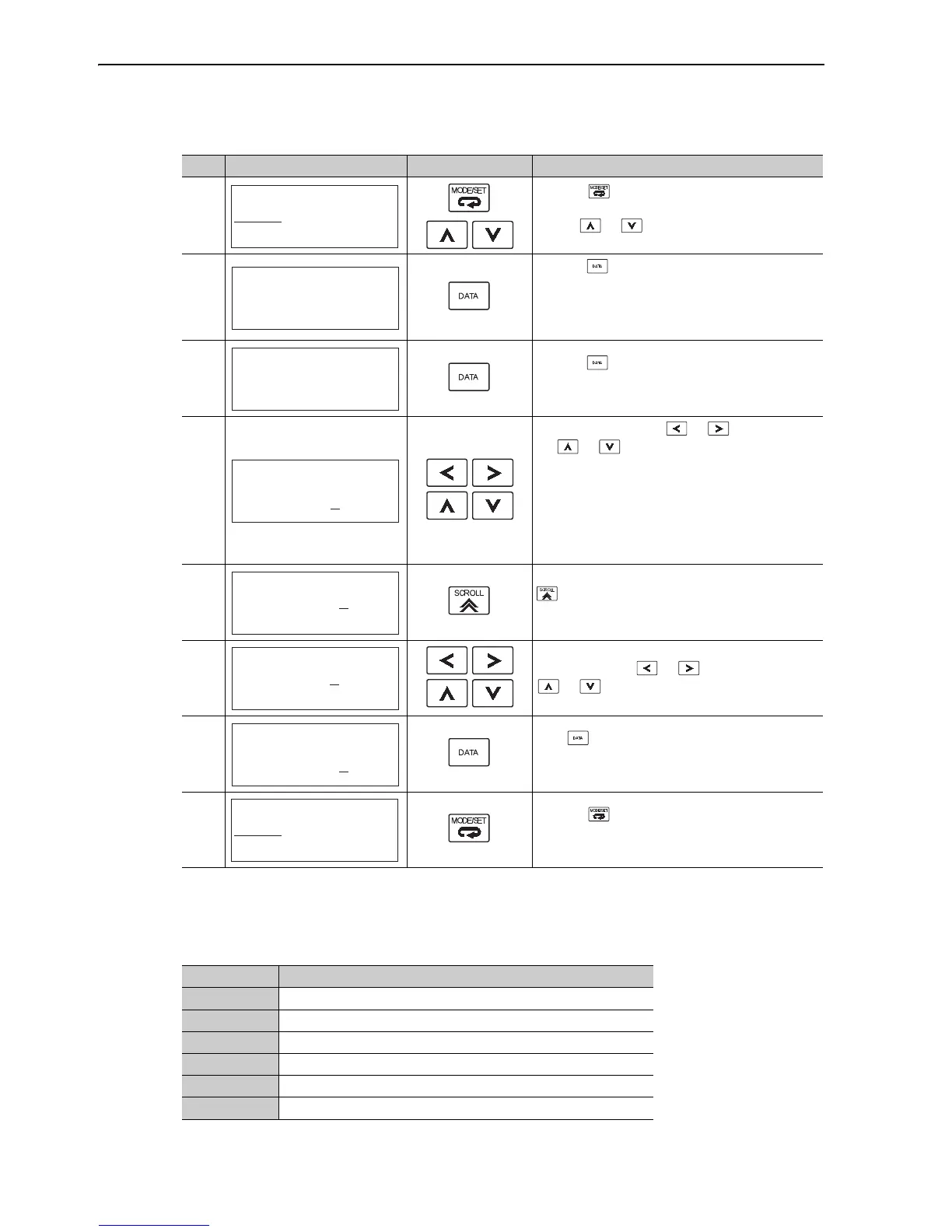6 Adjustments
6.6.3 Related Parameters
6-50
(3) For Fine-tuning After Adjusting the Anti-Resonance Control
6.6.3 Related Parameters
Pn160 and Pn161 are set automatically. The other parameters are not set automatically but the respective set
values in the parameters will apply.
Step Display after Operation Keys Operation
1
Press the Key to view the main menu for the
utility function mode.
Use the or Key to move through the list,
select Fn204.
2
Press the Key to display the "Tuning Mode = 1"
as shown on the left.
Note: If the display does not switch and NO-OP is
displayed, refer to 6.6.1 (1) Before Performing
Anti-Resonance Control Adjustment Function.
3
Press the Key while "Tuning Mode = 1" is dis-
played. The screen shown on the left will appear and
"damp" will blink.
4
Select the digit with the or Key, and press
the or Key to set the damping gain.
Note: Increase the damping gain from about 0% to
200% in 10% increments while checking the
effect of vibration reduction. If vibration reduc-
tion is still insufficient at a gain of 200%, can-
cel the setting, and lower the control gain by
using a different method, such as one-parame-
ter tuning.
5
If fine tuning of the frequency is necessary, press the
Key. The cursor will move from "damp" to
"freq". If fine-tuning is not necessary, skip step 6 and
go to step 7.
6
Select a digit with or Keys, and press the
or Keys to fine-tune the frequency.
7
Press Key to save the settings.
"DONE" will blink for two seconds and "RUN" will
be displayed.
8
Press the Key to complete the anti-resonance
control adjustment function. The screen in step 1 will
appear again.
㧾㨁㧺㧲㨁㧺㧯㨀㧵㧻㧺
㧲㨚㧞㧜㧟㧦㧻㨚㨑㧼㨞㨙㨀㨡㨚
㧲㨚㧞㧜㧠㧦㧭㨂㨕㨎ޓ㧿㨡㨜
㧲㨚㧞㧜㧡㧦㨂㨕㨎ޓ㧿㨡㨜
㧲㨚㧞㧜㧢㧦㧱㨍㨟㨥ޓ㧲㧲㨀
㧾㨁㧺㧲㨁㧺㧯㨀㧵㧻㧺
㧲㨚㧞㧜㧟㧦㧻㨚㨑㧼㨞㨙㨀㨡㨚
㧲㨚㧞㧜㧠㧦㧭㨂㨕㨎ޓ㧿㨡㨜
㧲㨚㧞㧜㧡㧦㨂㨕㨎ޓ㧿㨡㨜
㧲㨚㧞㧜㧢㧦㧱㨍㨟㨥ޓ㧲㧲㨀
Parameter Name
Pn160 Anti-resonance Control Selection
Pn161 Anti-resonance Frequency
Pn162 Anti-resonance Gain Compensation
Pn163 Anti-resonance Damping Gain
Pn164 Anti-resonance Filter Time Constant 1 Compensation
Pn165 Anti-resonance Filter Time Constant 2 Compensation

